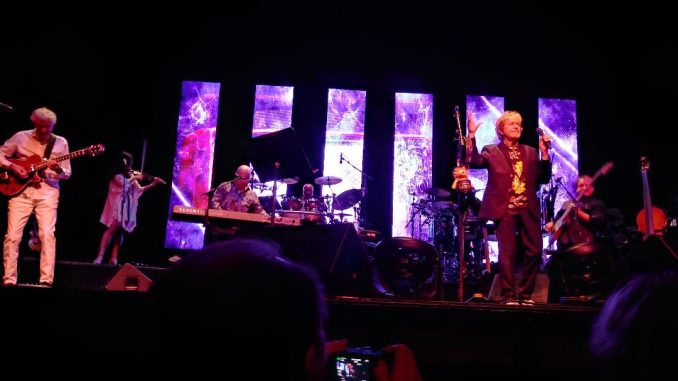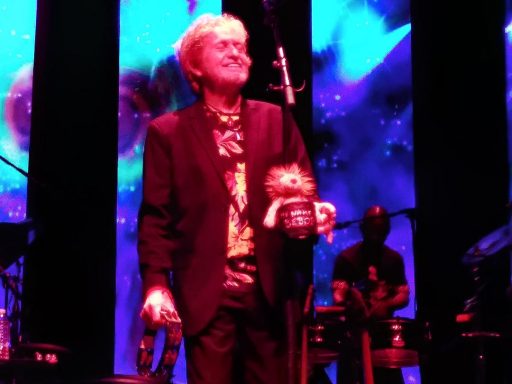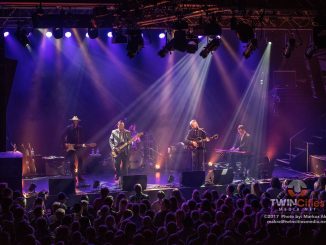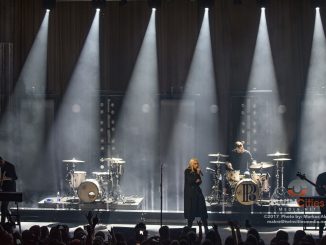
For those of us of a certain age and musical taste, the past few weeks in the Twin Cities have been remarkable. I’ll bet my bottom dollar that if you’re somebody who specifically looked up this review, you’ll know exactly what I mean. First, Mott The Hoople to get those 70’s juices flowing. Then Pink Floyd’s Nick Mason followed by Daryl Stuermer from Genesis. Cap it off tonight with Yes vocalist Jon Anderson at The Fitz. Talk about a target audience!
Having spent a good portion of my misguided youth, sitting in smokey, black lit rooms listening to all of the above mentioned bands, the past couple weeks of shows have reminded me what made that time, and artists like Jon Anderson, so important. It’s also led me to make the case that the music from the era of the early 70’s was simply…better.
A bunch of you are nodding in agreement right now. Before the rest of you decide to roast me in the comments section, allow me a chance to make my case. It isn’t just that all these bands landed in the Hall of Fame. You can get into the HOF for selling a lot of albums (thank you slick marketing) as well as being a band that forever changed the landscape. These bands were “better” because they had to be.
The early 70’s was a confluence of very few rules about what constituted rock. Things were still experimental. Bands that had the backing of major labels were not pressured into making hits or staying within any tried and true boundaries. Instead, the big bands called the shots, dictated to the record companies, broke the budget and came up with things that people had never heard before.
Genres were bent or mixed. Pink Floyd, Genesis and Yes are considered the Holy Trinity of Prog Rock. The very name describes what was going on. Bands were progressive; pushing the limits of rock forward in a big way. The new mantra was songs that shared elements of classical symphonies with movements that traced a complex mood or story, as opposed to clean, hook laden pop songs. You needed a lot of things to be able to truly pull it off. And why not? If you’ve got the musicianship along with new 24 track studios, synthesizers, etc for the first time, push the boundaries!
At the same time, stereo wars were in full swing in college dorm rooms and young men’s apartments. Those stereo systems remain unrivaled. They were affordable enough that if you didn’t have the money to build it, one of your friends without a trust fund certainly did. The party and the listening sessions gravitated to the stereo.
Bands like Yes understood this. And those recordings were so packed with nuance and startling originality that they almost dared you to try to listen on anything other than the best. It’s almost like a chicken or egg question. Did Yes succeed because there were stereos galore capable of reproducing them? Or did manufacturers like Pioneer, Sony and Marantz hit the mother lode because bands like Yes were drawing huge worldwide audiences?
It also occurs to me that there was also a lot more big money competition going on back then. Think back to the big bands and the albums they were putting out. From bands like The Who, to Elton John, to Yes, to Pink Floyd, to Genesis, to Supertramp; it was like a competition to see who could more thoroughly blow our minds with the next effort. We’re not many years removed from The Beatles most compelling years here. So why not think about success being defined as re-writing the script?
Finally, we were also in a period when things like consciousness expansion were taken pretty seriously. While things like Eastern philosophies, drugs, alternative lifestyles became quite close to mainstream. Some historical snapshots are so recognizable they almost become cliche’. How difficult is to conjure the image of a shaggy crew sprawled on ratty couches, a bong on a cluttered coffee table. Black lights watering through the smoke to illuminate a glowing poster of a sailing ship coursing through the stars. If it’s late at night, tell me what you hear on that stereo. (You know, that beautiful silver faced component system that had your square neighbor pounding on the wall, imploring you to turn it down. Not. A. Chance. It’s only 2am.)
Because music was seen as part of an alchemy that would carry us to a higher plane. Expand our consciousness. We laugh about it now but do you remember the seriousness of the effort?
To circle back to my original argument, can you remember the last time the music industry, from label, to artist, to gear manufacturer, to radio waves, to listening audience were all focused on beaming us to a higher plane? Make me intellectually work for it. Blow my mind. Produce something completely new. Not for the sake of profit. For the simple sake of high risk, experimental, consciousness expanding, genre bending…Art. It’s been a long time.
Did a record industry take all of that away from us because they adopted more predictable formulas to make their profits? Did artists sell out because they saw even bigger dollar signs when they merged their reputations with tried and true pop focus? I’m sure those played a part. But the more I think about it, the more apparent it becomes that we no longer get those sprawling rock masterpieces mostly because we, the audience, has changed.
When I first heard the Yes album, McDonalds was a novelty. A special treat. We were still years away from that modern convenience called a drive thru. Time passed more slowly. We had more available. If I was going to listen to Yes or an album like Dark Side of the Moon, I had to locate the album, remove it from the sleeve, clean the vinyl, drop the needle and take a seat. Because these things weren’t made to listen to casually; you committed to an album side at a minimum. Because we had time and it was ok to simply sit for an hour and listen. How many of us still do that? How many of us have a listening room with a dialed in listening spot any longer?
That’s why sitting at that Jon Anderson concert tonight reminded me of the need to commit to listening if you want to enjoy Jon Anderson or any of those incredible Yes classics he spun tonight. When I left the theater, I promised myself I’d go home. Put on any of those early Yes gems and open my mind. By the time I got home, I realized it would be hard to find the time, space and volume freedom to do it anytime soon. Life is fast. Things to do. Need to write a piece about Jon Anderson for TCM!

That’s a rambling reflection. But I wanted to raise the floor before doing a quick recap of the show. The name of the new album, twenty nine years in the making is 1000 Hands. It describes not only the all the people it took to make the album, it also describes what it takes to play in Anderson’s band or be part of this production.
Everything about the show was huge. All eight pieces of the backing band were virtuoso, many multi-instrumentalists. To pull off many of the Yes songs in the mix, you need to be. Six of the eight players were also vocalists which allowed the band to employ complex, multi-layered vocal arrangements. No bass voices need apply. Anderson is rock music’s most accomplished tenor. Around him were voices that reached for the ethereal. It was like listening to the Vienna Boys’ Choir overlaying the enormous power of the band. It was as much symphony and choir as Hall of Fame rock band.
The opening set compressed 45 minutes into about 5 as it flowed its way through a walk out of The Ocean from the underrated solo effort Olias of Sunhillow. The show’s first standing ovation came simply with Anderson’s presence. Into Owner of a Lonely Heart from the late Yes album 90125 and then Yours Is No Disgrace, from the 1971 debut album Yes.
Next up was Ramalama from the new album 1000 Hands. This was a more modern, vocal round with Indian overtones. It was during this first listening to the song that I twigged to the concept of the music’s spirituality. There is a joy and generosity to the song that connects to the roots that go back to those early 70’s years.
State of Independence acknowledged Anderson’s collaboration with the composer Vangelis in 1981’s wonderful Friends Of Mr Cairo. (Remember Chariots of Fire? Vangelis was a remarkable composer). Makes Me Happy from the new album was another sprawling masterpiece with Hakuna Matata African vibes, literally and conceptually.
Continuing the world music tour, the band rolled into a re-worked reggae based version of All Good People. The change was subtle and sublime. The audience immediately embraced it. Now we got to see the value of two percussionists. Adding the steel drum melodies was such fun.
The opening set concluded with an utterly original rearrangement of the Simon and Garfunkel classic America. I wondered if there was a purpose. This is a song of youth, simplicity and the wonders of our sprawling country. The country Anderson adopted years ago. I found myself thinking of how this song, when first written, was a balm to a country protesting in the streets. It seemed appropriate again today.
Following a twenty minute intermission, during which Anderson indicated they’d all have “a cup of tea and lie down”, (tea, yes I bet. Nap, I doubt) the stage reconfigured to allow an acoustic circle at the front of the stage. Flight of The Moorglade was shimmering and transparent. The complex architecture beneath the song on display. Same for the underrated Yes song Sweet Dreams that first appeared on the second release, Time And A Word.
The band moved back into it’s full blown configuration for To The Runner from Olias. What a thrill to hear two songs from this underrated classic! Despite all the Yes going on during those years with friends and roommates, I was the only one who had been able to lay hands on it. I cherished it simply because it was so rare.
The crowd immediately began to sing along Long Distance Runaround. During the line “Letting in the sunshine” Anderson subtly mimed taking a toke and smiled. This one wasn’t quite the original version. It looked back with a feeling of nostalgia as he intoned: “I still remember the dreams there.” Brilliant.
The new First Born Leaders was a carnival of upbeat joy. It demonstrated how easily Anderson moves between eras and decades. He then shared the story of how 1000 Hands came to be. Of why that music seems to so easily bridge the past and presence.
Twenty nine years ago Anderson was ensconced up in Big Bear to write some new music. He got word that former Yes band mates Chris Squire and Alan White were in LA. They agreed to meet at a studio and make some new music. Because of different agendas, schedules and the vagaries of life, nothing was ever released. The tapes ended up in Anderson’s garage. Three years ago, band keyboardist and producer Michael Franklin called Anderson and inquired about them. They were located, baked in an oven to bring them back to life and transferred to a hard drive. What they found was gold, the core of an album that would become 1000 Hands.
The song Come Up is a reflection of where each of the men was musically in 1989. Still sprawling and gorgeous. Yet definitely not Yes. Jazz infused and accessible. The audience clapping along. Aspects of a jazz exploration yet a bit more to the point.
Right into Starship Troopers and Solid Space. The pure joy and nostalgia that flowed from the audience was overwhelming. How many long evenings ended with those tunes? Music heads stumbling off to bed or dozing on the couch? We were a generation remembering our past and being reminded of how lucky we were to be consuming music during those days.
I want to make one more point here about Jon Anderson. The last time I saw him on a solo tour was probably 20 plus years ago. I distinctly remember him pointing out his wife and calling her the love of his life. Last night, there she was again. Sitting in the seat right in front of him. No person in that auditorium knows or loves that music more than she does. Her face was infused with joy through the entire show. Her hands a ballet set to the score. Throughout the evening, there were subtle winks and the occasional blown kiss to let her know they were together.
Prior to the encore, she exited the auditorium. The band quickly returned to the stage. The expected, the demanded encore was Roundabout. A song whose opening notes every guitar wannabe in the 70’s labored over for hours. It was familiar and incorporated an African based instrumental movement in the middle. Anderson dashed off stage during this section and I watched him take his wife in his arms and dance in the wings. May we all be so fortunate. The music of Anderson and Yes was always about love, hope and a better future.
What an April! Ian Hunter, Ariel Bender, Morgan Fisher, Nick Mason, Daryl Stuermer and finally Jon Anderson. Stuermer still has some years of tread left on the tires. He’s a good decade younger than the others. The others are closer to the end of their touring careers. Who knows how many more times they’ll hit the road? The Twin Cities was fortunate to see them go one more time. Still vibrant and powerful. Some of music’s greatest generation. We were so lucky then. We were lucky again last night at The Fitz.




To be quite honest, yoga, mysticism, vegetarianism, and drugs as a part of therapy are much more mainstream today than they were in 1970s. Back then it was groundbreaking what The Beatles and Yes were doing. Vegetarian diets have been shown by the great yogi MD, Dr. Dean Ornish, in repeated published research articles to reverse heart disease, and other doctors have followed through with reversing high blood pressure and diabetes using similar vegetarian diets. Meditation has also gained respect for it’s positive effects on the brain and human emotions, and there are hatha yoga centers in practically every city nowadays. There have also been artists that have promoted spirituality– in the 1980s Nina Hagen, in the 1990s Kula Shaker, in the 2000s Mason Jennings, in the 2010s Trevor Hall– it’s never really gone away as a source of inspiration for artists. There are also new books by Don Lattin and Michael Pollan on new research into the use of psychedelics for a variety of psychological ailments. In addition to this, marijuana is in the process of being legalized in the progressive areas of the US and in other progressive countries like Canada, in the same way gay marriage was legalized few years ago. In other words, the things that were “counterculture” in the early 1970s are taken for granted today by even some mainstream Christians in public polls– things like reincarnation which has been researched for 50 years at the Division of Perceptual Studies at the University of Virginia. So I don’t agree with the writer’s idea that these things are mere nostalgia for 1970s hippies.
Excellent review!
Great synopsis Jack! It’s always hard to describe the emotional connection to this kind of music. And you are correct that at it’s height, it was all about the music and Prog-rock followers were loyal to it. The energy and connection with the audience that was present at the Fitz really made this show a special experience. Only someone with Jon Anderson’s creativity could have pulled this off.
Very nice review ,but its not YES . Time and a Word was not their debut album btw
Ummmm Starship Trooper is from The Yes Album… not Relayer. C’mon Man…
Very nice review/article. I love your description of taking time to listen to a full vinyl LP back in the day, brings back a lot of memories – thanks Jack!
Great review!
Thank you for tying the current show into the days when this music was wondrous and new to us. It was raising our musical consciousness and the reason why it resonates is because we were listening intently.
The internal connection to our spiritual searching made an indelible mark. Hearing the music again, now that the decades have passed, life has passed, elections and wars have passed, friends and parents have passed, we feel the connection profoundly, like a planted seed that has secretly produced the towering tree; we feel joy in the rediscovery of our old friends- these songs- and gratitude for the new.